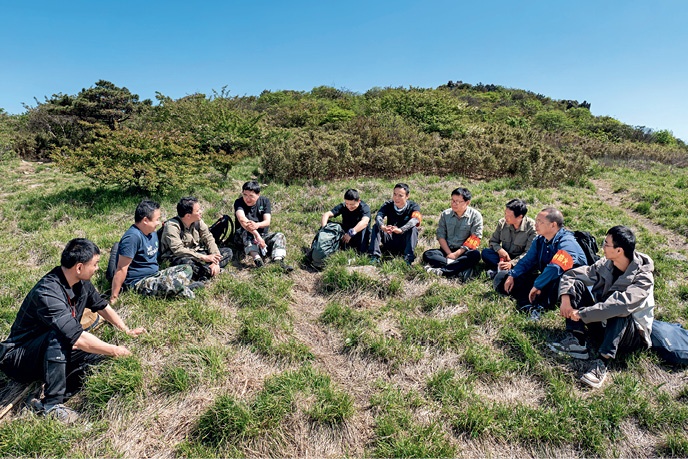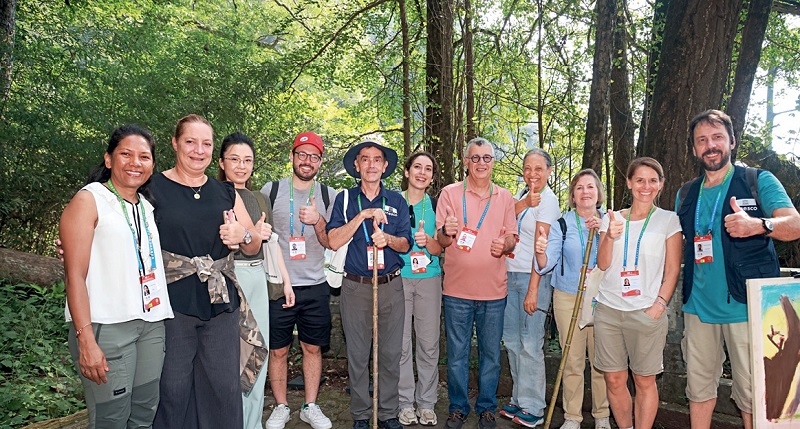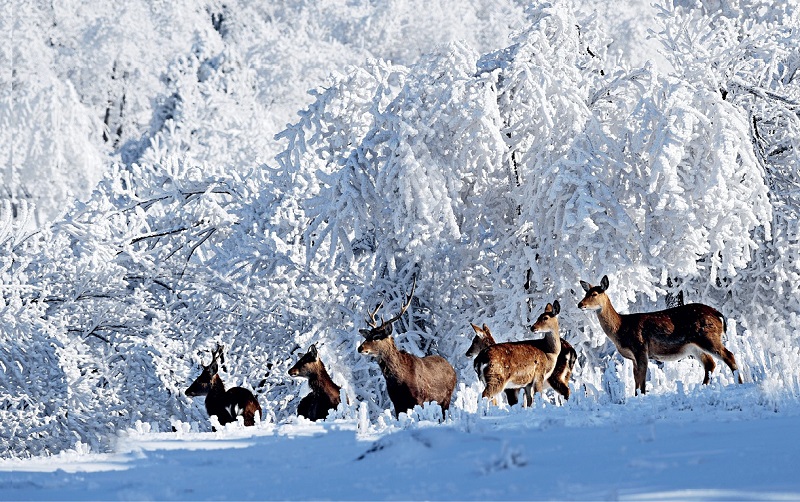
A sea of clouds seen in the Qingliangfeng National Nature Reserve. Photo courtesy of Liu Bailiang
It’s known as “paradise on earth,” and a city fittingly chosen to host the 5th World Congress on Biosphere Reserves (WCBR).
Hangzhou, in east China’s Zhejiang Province, opened its arms to this milestone gathering of the global ecological conservation community from September 22 to 25, which saw 4,000 scientists, policymakers, entrepreneurs, community leaders, and biosphere practitioners discuss the future of UNESCO’s 784 biosphere reserves in 142 countries.
Against a backdrop of intertwined global environmental crises, the congress theme, “Shaping a Sustainable Future for People and Nature,” served as a beacon, illuminating new pathways for the international community to find harmony between humanity and nature.
UNESCO launched the Man and Biosphere (MAB) Programme in 1971 to promote the sustainable management of natural resources for human-nature interactions. It operates through the World Network of Biosphere Reserves (WNBR) and convenes a congress every 10 years to evaluate the progress, share experiences, and set priorities and targets. This year’s WCBR marks the first time the conference has been held in Asia.
Defining a Biosphere Reserve
To better understand the significance and achievements of the WCBR, it is important to look at the genesis of a “biosphere reserve” and what distinguishes it from general nature reserves.
A biosphere reserve is a protected area designated by the UNESCO MAB Programme to promote the “harmonious coexistence of people and nature.” These reserves are intended to be samples of the world’s diverse ecosystems that function to conserve biodiversity, promote sustainable economic development, and conduct scientific research, education, and training.
A Biosphere reserve consists of three sections: a core area which is a strictly protected zone used for the conservation of landscapes, ecosystems, species, and genetic variations of habitats, plants, and animals; buffer zones which are the areas surrounding the core area that allow activities which reinforce scientific research, monitoring, training, and education; and the transition area where local communities can foster socio-culturally and ecologically sustainable economic and human activities.

Teams of rangers from Zhejiang and Anhui provinces conduct joint activities to patrol Qingliangfeng National Nature Reserve, since it borderlines both provinces. Photo courtesy of Liu Bailiang
China’s Biosphere Preservation
Of all the candidate cities in China for the WCBR, Hangzhou was chosen. Wang Zhangming, former deputy director of the Zhejiang Forestry Bureau and president of the Zhejiang Natural Protected Areas Federation, told China Today that the geographical features of Zhejiang Province have made it home to a variety of natural wonders. Currently, it has 316 Natural Protected Areas, along with two candidate national parks, 27 provincial-level or higher-level nature reserves, 15 marine special reserves (marine parks), 15 geological parks, 131 forest parks, and 68 wetland parks. Among these, Tianmushan-Qingliangfeng and the Nanji Islands are recognized as UNESCO World Biosphere Reserves.
The total area of protected zones in Zhejiang spans 14,700 square kilometers, accounting for approximately 9.6 percent of the province’s land area and 9 percent of its maritime territory. Nearly 10 percent of Zhejiang’s total area has therefore been designated as protected land or sea. Zhejiang has taken a leading role in institutional and mechanism innovation across the country.
The “Two Mountains Theory”
Twenty years ago in August 2005, while serving as the Party secretary of Zhejiang Province, Chinese President Xi Jinping first proposed the concept that lucid waters and lush mountains are invaluable assets, later known as the “Two Mountains Theory.” According to Wang, nature reserves are the core carriers of ecological construction, being rich in, and home to, the highest quality ecological products. While boosting green development and promoting common prosperity, Zhejiang has created its own experience.
One of the effective ways is to adopt the ecological compensation mechanism. For example the Qianjiangyuan-Baishanzu National Park pilot model that has increased the compensation standards for ecological public welfare forests.
“Through this green development financial incentive and subsidy mechanism, Zhejiang has disbursed a cumulative total of RMB 107.5 billion in awards and subsidies,” Wang said. For example, in the Baishanzu area of the Qianjiangyuan-Baishanzu National Park, banks have signed tripartite agreements with 32 administrative villages within the park area, providing a total of RMB 217 million in “ecological credit” to 3,691 forest farmers.
Since 2018, Zhejiang Province has initiated the construction of famous mountain parks. These parks consist of a protected area and the surrounding towns and villages, covering a large area. Through infrastructure improvement and the development of green ecological industries, they are strongly driving local economic growth, becoming examples of ecological value transformation and common prosperity in mountainous areas.
The second innovative approach through which Zhejiang is implementing the “Two Mountains Theory” is the cross-provincial ecological compensation mechanism co-established with Anhui Province since 2012. This mechanism operates on the principle of “ecological priority and source control,” and has produced remarkable outcomes. For over a decade, the water quality at the Xin’an River’s cross-provincial boundary section has consistently met or surpassed the Class II surface water standard. Annually, Anhui transfers nearly 7 billion cubic meters of high-quality water into Zhejiang’s Qiandao Lake, with the lake’s outflow water quality stably maintained at the superior Class I standard. As a result, the Xin’an River remains one of the highest-quality water bodies in China.

A group of representatives at the 5th World Congress of Biosphere Reserves take a photo during a scientific study tour of the Tianmu-Qingliangfeng Biosphere Reserve after the congress, in September 2025. Photo courtesy of Lei Jianfeng
The Story of a Biosphere Nature Reserve
To better understand just how President Xi’s “Two Mountains Theory” is being realized in Zhejiang’s nature reserves, China Today caught up with two deputy directors of the Administration of Zhejiang Qingliangfeng National Nature Reserve, Xu Weihua and Cheng Zhangfeng.
In 2024, the Tianmushan Biosphere Reserve which was designated by the International Co-ordinating Council of UNESCO’s MAB Programme in 1996, was combined with the Qingliangfeng National Nature Reserve to form the Tianmushan–Qingliangfeng Biosphere Reserve, covering an area now of 547km2.
According to Cheng Zhangfeng, the combination means that the mid-subtropical forest ecosystems within the protected area will be effectively conserved, while stable growth in populations of rare and endangered wildlife, and cultural diversity, will be preserved. By collaborating with surrounding communities, a large-scale regional biodiversity conservation framework will also be established.
As for development, sustainable development models in and around the protected core area will be further optimized, enhancing local’s sense of identity with the biosphere reserve, therefore achieving a balance between conservation and regional development.
According to Xu, the combination has also established tighter cooperation between the two biospheres in sharing resources, development plans, and dealing with natural emergencies like forest fires, all of which better promote preservation and development of the unique natural resources of mountain regions.
When asked about how the biosphere is helping stimulate local development, Cheng told China Today that the community management model of the Zhejiang Qingliangfeng National Reserve initiated back in 2013, encourages residents to actively participate in the management of the reserve, thereby breaking through the previous pattern of isolated efforts in conservation. At that time, traditional production activities in surrounding villages, such as those related to tea, honey, walnut, herb, and bamboo shoot, heavily relied on the well-preserved ecological environment established by the reserve.
Through giving reimbursements, or renting land or trees from residents when the land or natural resources have become part of the natural reserve, the reserve is protecting nature as well as meeting the financial needs of local residents. By involving locals living near or inside the biosphere reserve through job opportunities like protecting forests or planting ecological friendly crops, locals also become more aware of nature conservancy, as well as become active members in the perseveration work.
The reserve has assisted enterprises in leasing collective public buildings in Jiufu Village, Qingliangfeng Town, Lin’an District, Hangzhou, to establish a tea processing workshop, stimulating the development of over 133 hectares of tea plantations in the village. In collaboration with the China National Tea Museum, a “Common Prosperity Tea” brand was also launched. In addition, support was provided to the Sunjia Village and Lianmeng Village in Changhua Town, Lin’an District, Zhejiang for the under-forest cultivation of medicinal herbs across more than 200 hectares in the Daluntang Jinluyuan Ecological Planting Garden. Furthemore, over 100,000 alpine rhododendrons were cultivated in the Maoshan forest area, to name a few examples.

Manager of the Hangzhou Lin’an Yifeng Agricultural Development Co., Ltd. is introducing the Chinese herbs that are grown in the Chinese medicinal herb base in the Qingliangfeng National Nature Reserve.
One Young Man’s Dream Comes True
At the age of 25, Yu Yemin, a resident of Yuqian Village in Hangzhou’s Lin’an District, set his sights on a mountain area nestled atop a 1,000-meter-high peak in Changhua Town belonging to the transition zone (sustainable development zone) of the Qingliangfeng section of Tianmushan–Qingliangfeng Biosphere Reserve. For many years Yu had worked in the rosewood industry. Then in 2019, he sold his business and invested in the development of this area.
Leveraging the region’s abundant forest resources, favorable climate, and unique high-altitude environment, Yu established Hangzhou Lin’an Yifeng Agricultural Development Co., Ltd. The company has developed a forest medicinal herb base, creating an eco-wellness resort that successfully translates ecological advantages into economic and social benefits.
“Soon after we began to develop this area, we found it was highly suitable for cultivating premium medicinal herbs,” Yu told China Today. The forest zone has now taken shape, spanning a total area of around 166 hectares. The initiative has facilitated the formation of integrated interest alliances between leading understory medicinal herb enterprises and villages such as Lianmeng Village, establishing a tightly knit mechanism that links business entities and farmers. This allows farmers to participate in operations and profit-sharing, creating a new mutually beneficial community that enhances agricultural income.
Yu’s experience illustrates how ecological conservation – protecting lucid waters and lush mountains – can go hand in hand with economic development – gaining gold and silver mountains. His story is one of many examples where green industries around China’s nature reserves are stimulating sustainable growth in surrounding communities.

A herd of protected sika deer wintering in the Qingliangfeng National Nature Reserve. Photo courtesy of Zhang Shuyan
Outcomes of the 5th WCBR
The 5th WCBR served as an important platform for demonstrating to the world China’s achievements in biosphere preservation.
When asked about the congress, Antonio Abreu, secretary of the MAB Programme, said, “It is a milestone both in logistics and in vision.” He also commented that the congress produced two landmark outcome documents, the Hangzhou Strategic Action Plan for the MAB Programme (2026-2035) and the Hangzhou Declaration (2026-2035). Together, these provide a global roadmap for strengthening the MAB network and reaffirming the role of biosphere reserves as learning sites for sustainable development.”
The documents call for enhanced integration across several key areas: linking scientific research with public policy, leveraging digital innovation to cultivate young talent, and deepening international cooperation. These concerted efforts are directed towards establishing a sustainable development model that prioritizes ecological preservation and restoration. The ultimate goals are to slow and adapt to climate change, empower communities via the green economy, expand nature-based education and research, and improve collaborative monitoring of the World Network of Biosphere Reserves.
Deputy director of the Qinliangfeng National Nature Reserve Cheng Zhangfeng, told China Today he felt a strong resonance with the plans outlined in the Hangzhou Declaration, especially those about digital innovation, increasing regional economic benefits, and creating flagship species intellectual properties, which are closely associated with the work of nature reserves.
Looking ahead to the next decade of biosphere innovation, both Wang Zhangming and Cheng Zhangfeng, suggest that species preserved within nature reserves could be recovered in such significant numbers that they may be reintroduced into provinces – or even countries – where they historically thrived but have since gone locally extinct.
One example is the sika deer currently protected in the Qingliangfeng National Nature Reserve. Historical records show that sika deer once lived in other Chinese provinces as well as in Korea, but later vanished from those areas. Such reintroduction efforts would not only strengthen inter-provincial and international collaboration in biosphere conservation, but also contribute to better species preservation – potentially even leading to the emergence of new types.
The conclusion of the 5th WCBR marks the beginning of a new era. The Hangzhou Declaration and its action framework have injected new confidence and momentum into global ecological governance.
Protecting the Earth’s biosphere is protecting our own future. This journey towards 2035 requires the collective participation and relentless efforts of every nation, every community, and every individual.